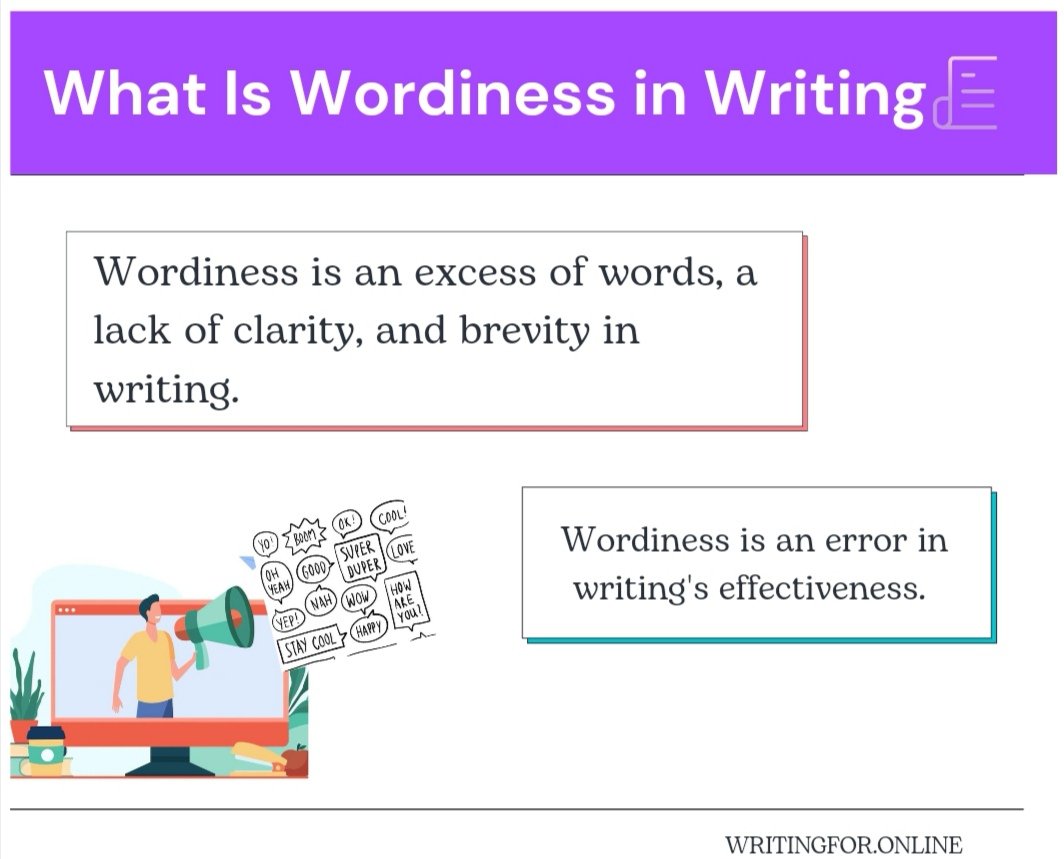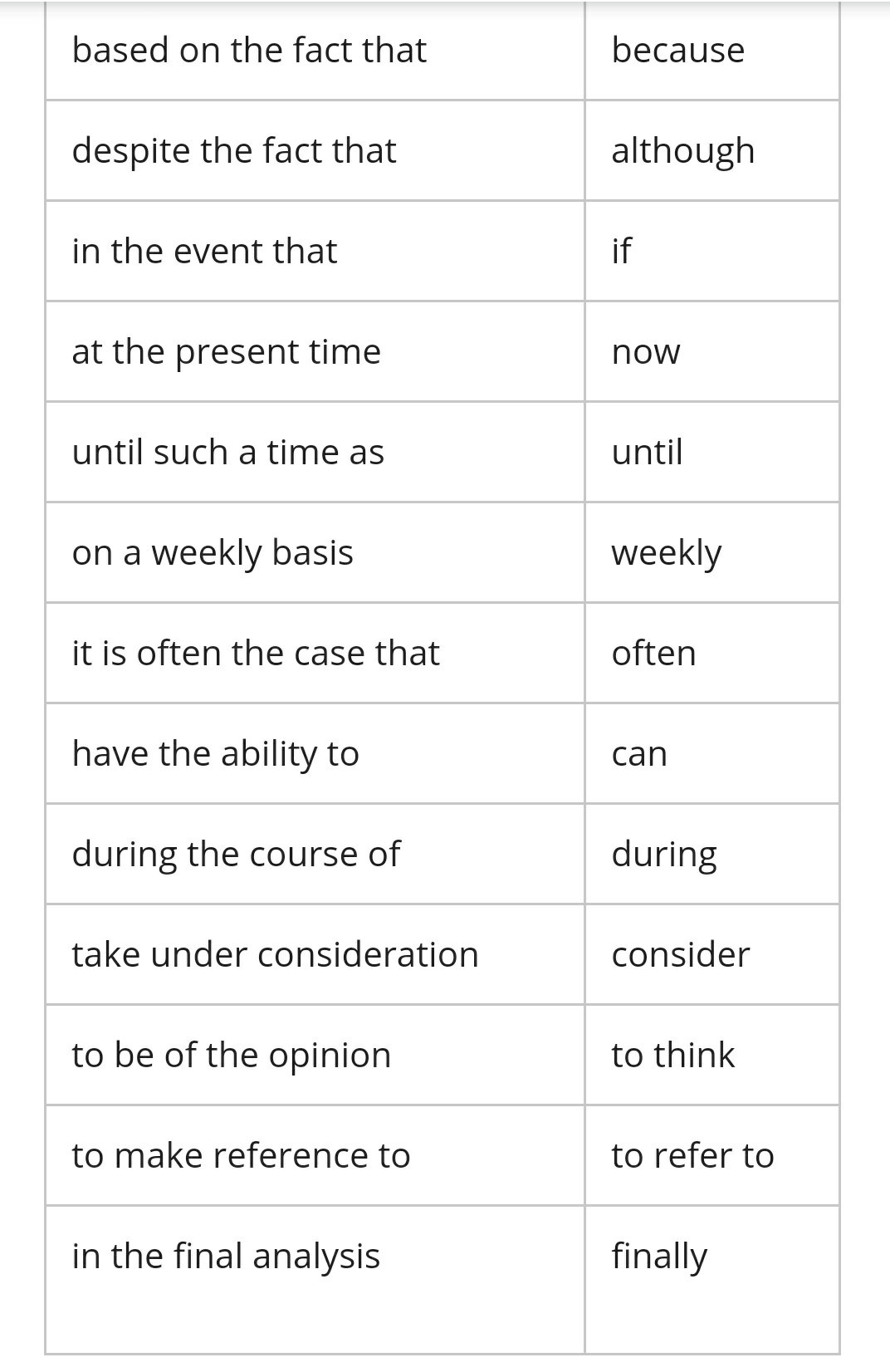In this article, you will learn what wordiness is, why it is a problem, the types and examples of wordy sentences, and how to eliminate wordiness in writing.

In a good text, everything should be in moderation: the correct writing style, the proper tone, the competent presentation of information, and, most importantly, the words, they also need a measure. In this article, you will learn why it is bad when there are too many words.
A Lot – Doesn’t Equal to Good or Why Wordiness Is a Problem
We think that more words are better: more persuasive, more informative, and more profound will be our writing. But that is not true:
- Wordiness reduces the chances of success. After all, to become a professional in your field, you need the communication skill to clearly and persuasively express your thoughts.
- Wordiness kills the reader’s interest. We live in a time when the sooner, the better. Most often, people want to read the text fluently, get the most useful information out of it, and not spend a lot of time on reading.
- Wordiness makes the text difficult instead of simple, incomprehensible instead of understandable.
This problem is typical for formal writing (for business texts and scientific writing style).
What Is Wordiness
Wordiness (verbosity) is an excess of words, a lack of clarity, and brevity in writing.
Wordiness is an error in writing’s effectiveness.
In other words, wordiness is the use of unnecessary words resulting in vague, timid, long sentences.
Types and Examples of Wordiness in Writing
Let’s take a look at what types of wordiness are, the reasons for their occurrence, and, of course, examples.

What Causes Wordiness
Pleonasm
Pleonasm is a figure of speech in which there is a duplication of meaning; the presence of several language forms expressing the same meaning within a complete segment of the text; as well as a language expression in which there is such duplication.
Example of pleonasm:
“And if he wore a mask in his commerce with men, it was like that iron one of the Bastile, which when put on, was put on for life, and was at the same time of iron”.
Tautology
Tautology is the repetition of the same or similar words. For example:
- “We went in an omnibus to the depot, and then went to Detroit in the cars that went that day to Chicago”.
You can avoid the tautology by the use of equivalent or synonyms words:
- “We rode in an omnibus to the depot, and then proceeded to Detroit in the cars that went that day to Chicago.”
Poor vocabulary
If we have a poor vocabulary, then we don’t know enough ways to express our thoughts. Therefore, we will use those words and phrases that are entrenched.
A few examples of pleonasms from colloquial language:
- very huge – huge,
- run fast – run,
- unexpected surprise – surprise,
- morning sunrise – sunrise.
- first time to meet – meet,
- a crowd of people – crowd,
- heavy snowfall – snowfall.
Filler words
The filler words make the text frivolous. They do not carry any valuable information, but only clog the text and distract the reader’s attention from the main idea.
The filler words often act as a booster for other, more important words.
Instead of: “They just built a huge office building near our house”.
It’s better to write: “A 50-story building was built near our house.”
Examples of filler words are:
- umm,
- ahh,
- like,
- you know,
- maybe,
- just,
- guess,
- sort/kind of.
The overuse of participle phrases
A participle phrase is a modifier (adjectival or adverbial) and begins with a participle verb.
Bad: “The car belonging to Mr. Smith is in the garage.”
Better: “Mr. Smith’s car is in the garage.”
Redundant phrases
For example:
- At this point in time – For now.
- On a daily basis – Every day.
- In due course – Finally.
- Prior to – Before.
- A number of clients – Several clients.
- A variety of procedures – Some procedures.
- Exactly identical – Identical.
- Actual facts, truly facts – Facts.
- Crisis situation – Crisis.
- Successfully completed – Completed.
More examples of phrases that need to be shortened:

Read also previous post “Common Stylistic Errors in Writing and How to Avoid Them”.
How to Eliminate Wordiness in Writing: 6 Strategies
To eliminate wordiness from the text, follow these recommendations:
- Use fewer adjectives and adverbs. If possible, choose one word that reflects both the meaning and the definition (heavy snow – snowfall, light wind – breeze).
- Find all the long sentences in the text and try to shorten them while keeping the meaning:
“For all intents and purposes, American industrial productivity generally depends on certain factors that are really more psychological in kind than of any given technological aspect.” (wordy)
Better: “American industrial productivity depends more on psychological than on technological factors.”
- Read the text aloud. Reading word by word, you will understand what can be removed from the text. People perceive information by hearing better than visually.
- Use the active voice.
Make the subject perform the action of the sentence.
“The bill was paid by us – We paid the bill.”
“The results were analyzed – We analyzed the results.”
- Avoid the phrases “there is”, “there was”, and “this is” at the beginning of the sentence.
Use action verbs rather than forms of the verb “to be”.
Wordy: “There are a larger number of applications…”
Better: “A larger number of applications…”
- Eliminate phrases that use to make your statement stronger: I think, in my opinion, I believe, I feel.
Conclusion
Eliminating wordiness and pleonasms from the text will take some time. But it’s worth it.
The text will be easier to read, the information will be perceived better, and your reader will definitely come back for a new portion of good material.
P. S.: If the article was interesting to you, please, share the link on social networks! Thank you!
Used sources of information:
- Analysis of Letter-writing: With a Large Number of Examples. By Calvin Townsend.
- Edgar Allan Poe: Rhetoric and Style. By Brett Zimmerman.
- Mastering the Craft of Writing: How to Write With Clarity, Emphasis, and Style. By Stephen Wilbers.
- A Coursebook on Scientific and Professional Writing. By M.N. Hegde.
- Images: freepik.com.